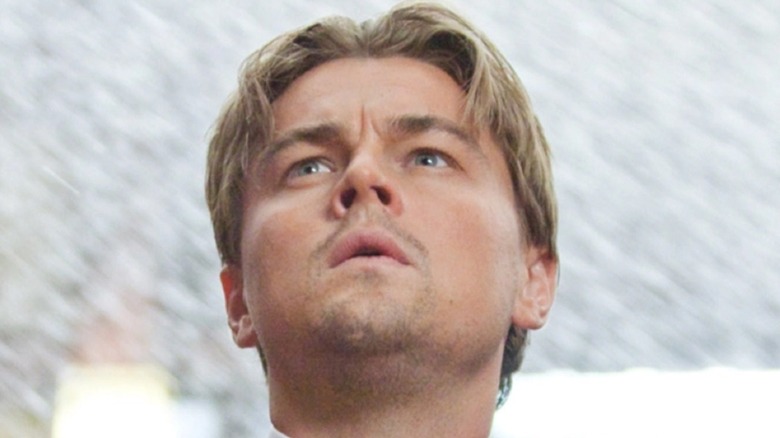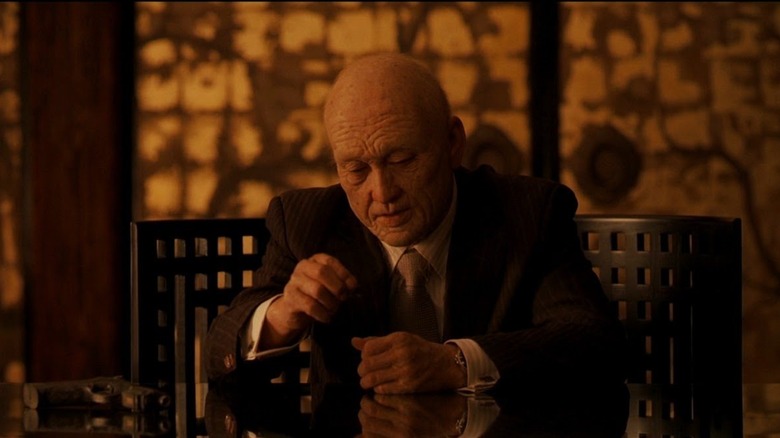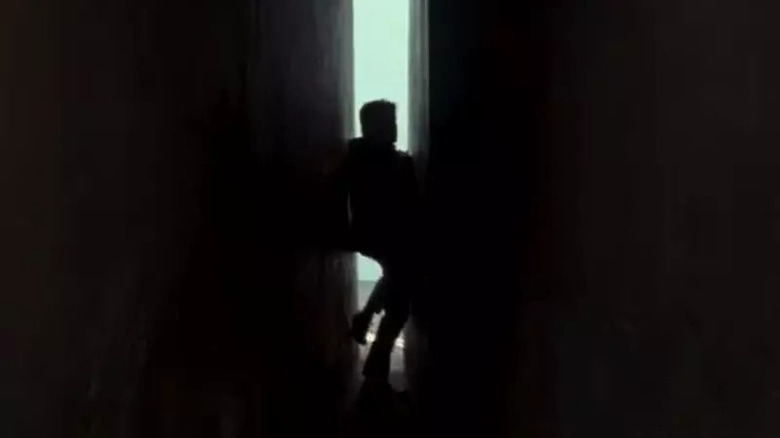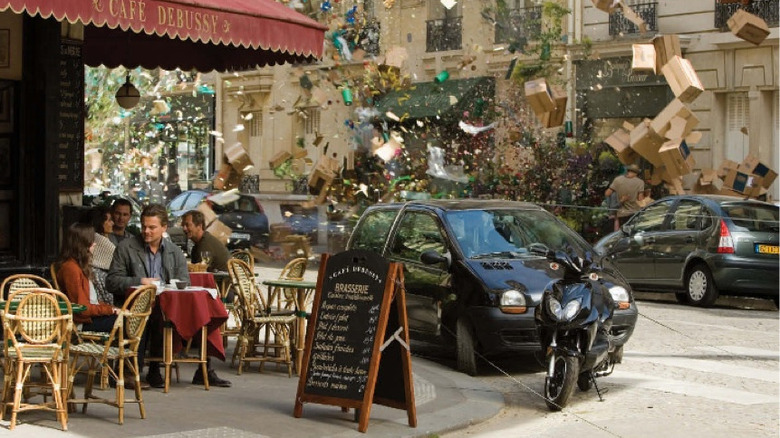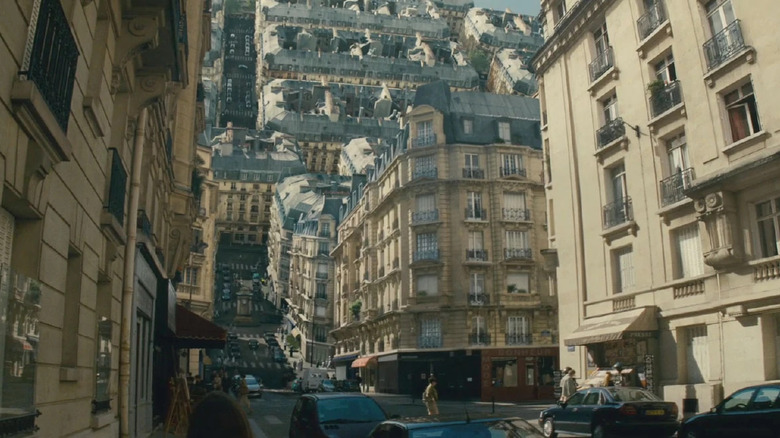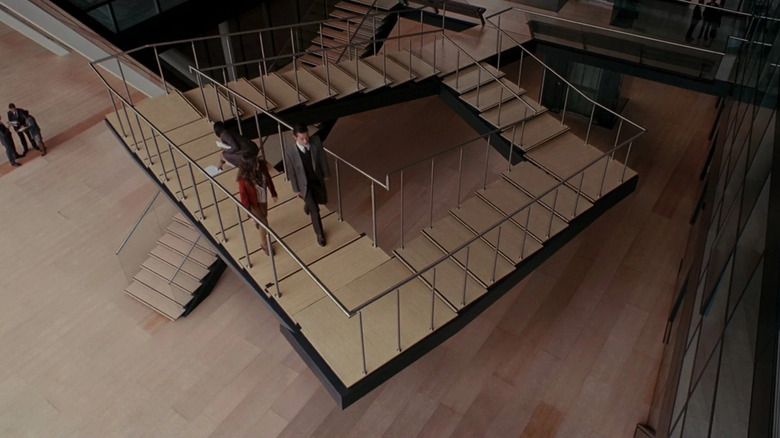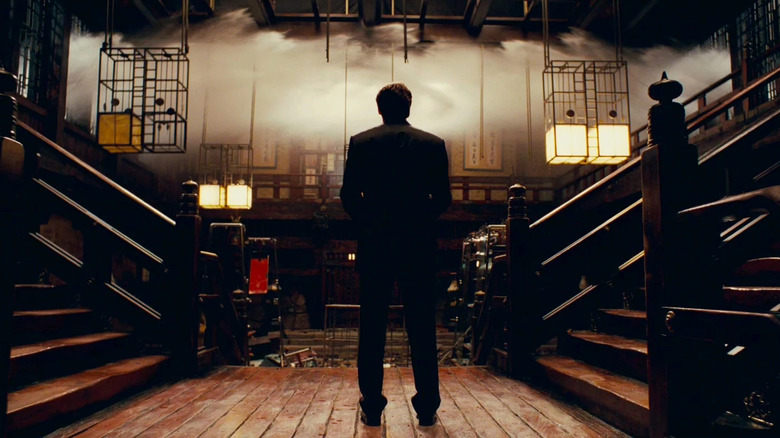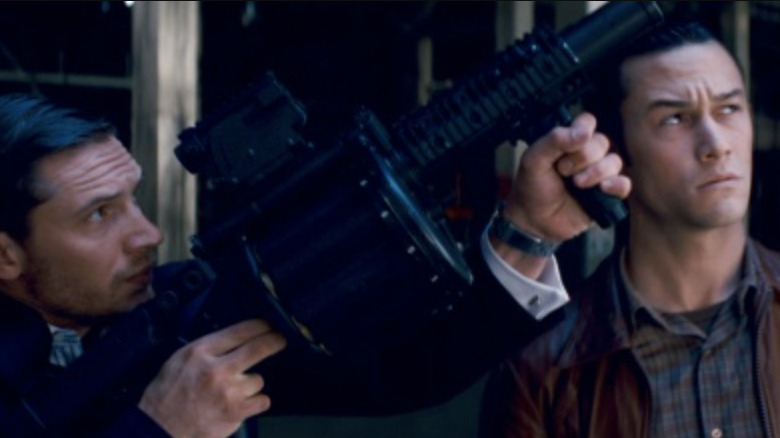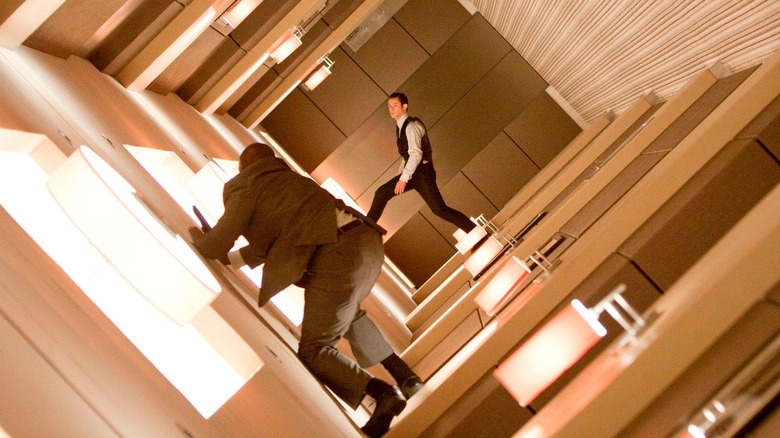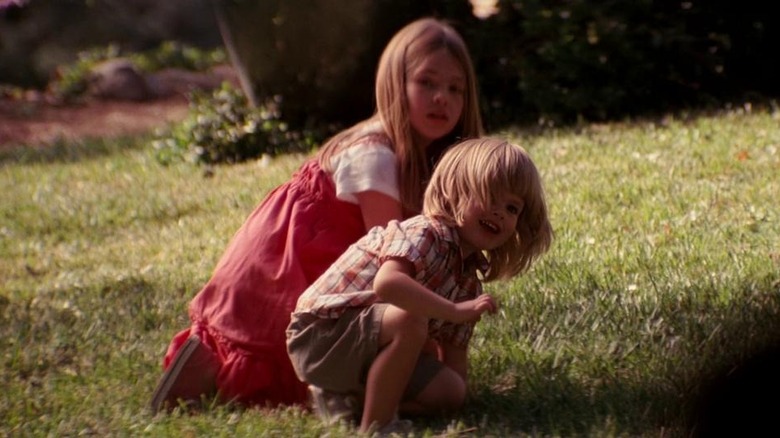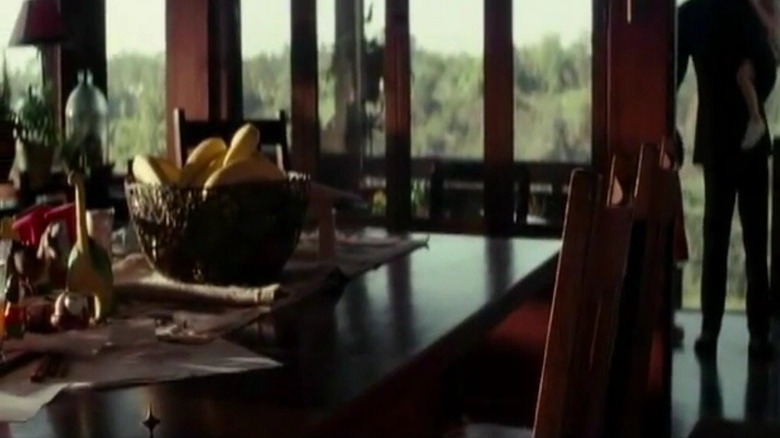The Most Pause-Worthy Moments In Inception
Director Christopher Nolan's masterpiece film "Inception" came out a little over a decade ago in 2010. The ambitious picture received positive reviews for being completely original with a stunning all-star cast from around the globe. This mind-bending action-packed thriller stars Leonardo DiCaprio as Dom Cobb, a man on the run after being wrongly accused of his wife's murder. He specializes in dream infiltration to extract secrets from his targets while they're in a dream state. Cobb uses his talent to strike a deal with Saito, an influential businessman who can get the murder charges against Cobb dropped. This will allow him to return home to see his children.
Due to the concept of this film, the majority of the story takes place in the dream world, allowing for some outstanding visuals that both wowed and delighted audiences during its release. All these years later, those excellent visuals still hold up. So, to celebrate its enduring appeal, here's a look at the scenes in "Inception" that make for the most pause-worthy moments of the film.
The meeting with Saito
The film begins with a disgruntled Cobb being brought before a seemingly powerful old man named Saito. The scene is built up with tension as the audience senses the danger that Cobb is in without truly understanding why just yet. As Cobb and Saito have a conversation, it becomes apparent that the old man's voice is that of actor Ken Watanabe. For those familiar with the actor, they were likely to pause the scene to ensure that they weren't losing their minds. It's possible that they would ask themselves if this older-looking man was truly Watanabe.
However, even if you are not familiar with Watanabe's work, you'd still likely pause this scene, as it's clear that there is more to this character than meets the eye. Even upon a second viewing, when you're already aware of who Saito is and why Cobb has come to get him, there is still a justified reason to pause this scene. You'd want to witness just how masterfully Nolan has aged Watanabe into an almost unrecognizable face.
The Mombasa chase
In "Inception," Cobb attempts to collect a team of the best minds to help him with the dream heist task that he's been assigned by Saito. As his reward will allow him to finally be reunited with his children, Cobb is highly motivated to get the job done.
He heads to Mombasa to recruit Tom Hardy's Eames, a master impersonator who Cobb needs to pull this job off. However, while in Mombasa, Cobb gets chased by agents from another job-gone-wrong. It's in this stressful and high-action scene that audiences see Cobb running for his life. He goes down an alleyway and attempts to push his way between two buildings that are tightly placed together. At one point, it's unclear if Cobb will make it between the two buildings. It's this scene that audiences would likely pause to further inspect, questioning just how thin the space between the buildings actually is, wondering if it's actually possible that Cobb manages to fit through.
The scene feels and looks claustrophobic, so it's no surprise that DiCaprio said during a Warner Bros. press tour that shooting that chase scene was the most physically challenging part of filming "Inception."
The exploding boxes
Cobb almost has every team member needed for his dream heist that will allow him to return home to his children. However, he needs an architect who can design the dream world, and he needs one who is just as good as he was before he stopped designing. This is when he's introduced to Elliot Page's character Ariadne, a promising architecture student who impresses Cobb with her skill.
In order to explain what the job entails, Cobb and Ariadne have lunch at a café in Paris. Eventually, Cobb lets Ariadne and the audience know that their conversation is taking place inside a dream. Once Ariadne becomes aware of this, she — understandably so — starts to freak out, and the city around them erupts in explosions as they stay seated at the café.
According to MTV, this scene was filmed with actual air cannons to create the explosive effect. This was done while the actors were sitting there in order to make the shot as realistic as possible. This information definitely makes the scene pause-worthy, as audiences are likely trying to catch an in-the-moment snapshot of the actors' organic reactions to the explosions.
The Paris dream world
Following the explosive Parisian café scene, Ariadne and Cobb take a walk through the dream to test the limitations the world presents. As an architect student, Ariadne begins to play around with the architecture of the city, questioning if physics comes into play when designing a world.
She answers that question when she folds a city block on top of another. The scene is absolutely stunning and shows why Nolan is a master at his craft. The visual effect is so realistic that you would be forgiven for pausing and re-watching the scene over and over again. The idea of seeing a city street bending to such an extreme length is exciting and certainly sets the tone for what audiences will see from "Inception" moving forward.
The staircase paradox
Once the dream heist is on, Joseph Gordon-Levitt's Arthur takes it upon himself to teach Ariadne the fundamentals of being in and designing a dream world. He introduces her to the never-ending staircase, otherwise known as the Penrose staircase. It's Arthur's hope that the paradox of the staircase will allow Ariadne to construct a never-ending dreamscape for the heist.
According to Wired, the Penrose staircase forces people into an "upward loop." This term was developed by Lionel and Roger Penrose, famous mathematicians who were also father and son. They surmised that a paradox loop such as this could never exist in a three-dimensional reality. However, in Nolan's dream universe, it is the perfect fit. While the paradox staircase is showcased twice in the film, it's the first time that would likely cause viewers to pause and try to figure out just how the staircase actually works. This scene also neatly explains the entire concept of "Inception" — the idea of illusions that question what's real, and what's not.
The dream is collapsing
Near the beginning of the film, Cobb has been hired to infiltrate Saito's dream to steal privileged information. To do so, he creates a dream within a dream to trick Saito into revealing the intelligence he needs. It's thanks to this job that Saito hires Cobb for the dream heist later in the film, as he's impressed by his methods.
This scene shows Cobb attempting to unlock Saito's secrets before he's given a "push" to wake up. That "push" sees Cobb falling into a bathtub of water to leave the dream. The moment his body hits the water, audiences see Cobb in the dream get engulfed by an ocean-like wave. The water is so strong that it bursts through the windows of the room Cobb is standing in as he's reading the information he's trying to steal from Saito. This scene is powerful as it explains how dreams work in the "Inception" world. It also gives audiences a moment to pause and watch as this powerful wave of water is about to hit Cobb, and the real-life actor portraying him.
The bigger dream
In a funny little piece of dialogue between Arthur and Eames, this pause-worthy scene is small but mighty. Throughout the film, Eames has adamantly maintained that Arthur doesn't have an imagination. Eames argues that Arthur is more straightforward and doesn't think outside of the box. This is the complete opposite of the imaginative and go-with-the-flow personality of Eames.
In this scene, Arthur is engaged in a shoot-out during their dream heist. As he's shooting, Eames saunters over and tells him that he "mustn't be afraid to dream a little bigger, darling." He takes the gun and lowers it off-screen before pulling a much larger weapon back up and firing to stop the enemy. This blink-and-you-miss-it moment is one that surely has audiences pausing to double-check if the weapon has, in fact, changed to something much bigger. While this may not be the most epic moment on the list, it sure is a crowd-pleaser.
The zero gravity hallway
Since it's one of the most talked-about moments from the film, it's no wonder that the epic hallway sequence makes our list of most pause-worthy moments. This scene shows Arthur fighting an endless amount of security with zero gravity while simultaneously trying to find a way to great a big enough "push" that would ultimately wake his team up from the dream heist.
This scene stands out for various reasons, not the least of which is the fact that it was shot entirely without CGI. Nolan and the "Inception" crew built a rotating set and attached Gordon-Levitt to wires in order to achieve the effect of zero-gravity. It is so well done that most of Gordon-Levitt's fight scenes need to be paused in order to analyze the full details of the shots. Gordon-Levitt reportedly trained for 12 weeks in order to do all his stunts for this scene, and clearly, it paid off because the scene is still an all-timer today.
The faces of Cobb's children
By the end of the film, Cobb has seemingly been successful in his dream heist. He is rewarded by being able to go home and finally see his children. While this is an incredibly emotional scene, it's also arguably one of the most-paused moments in "Inception." Throughout the film, Cobb never looks at the faces of his children, even when he's remembering them or experiencing his time with them in a dream. This is because he wants to see them for himself one day in the real world.
And it seems as though he finally gets that chance in the film's finale. Or does he? Once he sees his kids, they turn and face him, allowing Cobb and the audience to finally see their faces. The only problem is that the kids look mysteriously the same as in his memory of them. They're doing the same thing — playing together outside — and they wear similar clothes as in his memories. They also seem to be the same age as before; it's as though time has stood still for his kids. Once pausing to take a closer look, it's clear that these kids haven't aged a day. Therefore this pause-worthy scene brings up the question, is this real or not?
The cliffhanger ending
The ending of "Inception" is not just the most-paused moment but likely the most talked-about one as well. Throughout the film, audiences see Cobb spinning his totem to help him distinguish the difference between reality and the dream world. The film dares audiences to ask what the definition of reality truly is. If someone feels more connected to the dream world, why can't that be their reality?
This is something Cobb struggles with as he clings to his wife who's trapped in the dream world. He desperately wants to get back to his kids and to reality, but by the end of the film, it doesn't really matter to him whether it's real or not. It's real to him.
"Inception" ends with Cobb's spinning totem. Audiences never quite see it topple over, which begs the question of if he's in the dream world or not. This scene is likely to be the most-paused moment as we're begging to see if the totem topples over, thus signaling that it's reality and Cobb is free. But no matter how many times we pause it, audiences never truly get an answer one way or another. Nolan himself has said that Cobb is where he belongs in the end, whether it's the dream or not. As the film suggests throughout, who are we to say what's real and what isn't?
